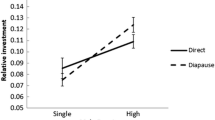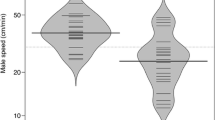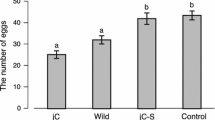Abstract
The seed beetle Callosobruchus maculatus larvae exhibit two types of resource competition: scramble, in which a resource is shared, and contest, in which the resource is monopolized. This difference in larval behavior results in different adult densities. Under contest competition, adult density remains constant regardless of larval density, but under scramble competition, adult density increases with larval density. This in turn affects mating frequency during adulthood, and thus, the intensity of sexual selection operating on males. In this study, we examined the relationship between larval competition types and male reproductive investment in mating. We assessed the male ejaculate expenditure per mating across geographic strains of C. maculatus. The male investment (ejaculate expenditure) increased with the degree of scramble competition and decreased with the degree of contest competition. We therefore suggest that males experience different selective pressures depending on the type of larval competition: scramble type males are selected for increased reproductive investment.

Similar content being viewed by others
References
Arnqvist G, Rowe L (2005) Sexual conflict. Princeton University Press, Princeton and Oxford
Brown EA, Gay L, Vasudev R, Tregenza T, Eady PE, Hosken DJ (2009) Negative phenotypic and genetic associations between copulation duration and longevity in male seed beetles. Heredity 103:340–345
Cook P, Gage MJG (1995) Effects of risks of sperm competition on the number of eupyrene and apyrene sperm ejaculated by the male moth Plodia interpunctella (Lepidoptera: Pyralidae). Behav Ecol Sociobiol 36:261–268
Crudgington HS, Fellows S, Badcock NS, Snook RR (2009) Experimental manipulation of sexual selection promotes greater male mating capacity but does not alter sperm investment. Evolution 63:926–938
Dewsbury DA (1982) Ejaculate cost and male choice. Am Nat 119:601–610
Dziminski MA, Roberts JD, Beveridge M, Simmons LW (2010) Among-population covariation between sperm competition and ejaculate expenditure in frogs. Behav Ecol 21:322–328
Eady PE (1994) Sperm transfer and storage in relation to sperm competition in Callosobruchus maculatus. Behav Ecol Sociobiol 35:123–129
Eady PE (1995) Why do male Callosobruchus maculatus beetles inseminate so many sperm? Behav Ecol Sociobiol 36:25–32
Edvardsson M (2007) Female Callosobruchus maculatus mate when they are thirsty: resource-rich ejaculates as mating effort in a beetle. Anim Behav 74:183–188
Firman RC, Simmons LW (2008) The frequency of multiple paternity predicts variation in testes size among island populations of house mice. J Evol Biol 21:1524–1533
Fox CW, Moya-Larano J (2009) Diet affects female mating behaviour in a seed-feeding beetle. Physiol Entomol 34:370–378
Gage MJG (1995) Continuous variation in reproductive strategy as an adaptive response to population density in the Moth Plodia interpunctella. Proc R Soc B 261:25–30
Gay L, Hosken DJ, Vasudev R, Tregenza T, Eady PE (2009) Sperm competition and maternal effects differentially influence testis and sperm size in Callosobruchus maculatus. J Evol Biol 22:1143–1150
Hosken DJ, Ward PI (2001) Experimental evidence for testis size evolution via sperm competition. Ecol Lett 4:10–13
Hunter FM, Birkhead TR (2002) Sperm viability and sperm competition in insects. Curr Biol 12:121–123
Isbell LA (1991) Contest and scramble competition: patterns of female aggression and ranging behavior among primates. Behav Ecol 2:143–155
Kelly GD, Jennions MD (2011) Sexual selection and sperm quality: meta-analyses of strategic ejaculation. Biol Rev 86:863–884
Lewis Z, Sasaki H, Miyatake T (2011) Sex starved: do resource-limited males ensure fertilization success at the expense of precopulatory mating success? Anim Behav 81:579–583
Mano H, Toquenaga Y (2008a) Wall-making behavior in Callosobruchus maculatus (Coleoptera: Bruchidae). Annal Entomol Soc Am 101:449–455
Mano H, Toquenaga Y (2008b) Wall-making behavior as a proximate mechanism to generate variation in larval competition in Callosobruchus maculatus (Coleoptera: Bruchidae). Evol Ecol 22:177–191
Mano H, Toquenaga Y (2011) Contest-type competition between age classes in scramble-type Callosobruchus maculatus (Coleoptera: Bruchidae). Entomol Sci 14:166–172
Martin OY, Hosken DJ (2003) The evolution of reproductive isolation through sexual conflict. Nature 423:979–982
Martin OY, Hosken DJ (2004) Copulation reduces male but not female longevity in Saltella sphondylli (Diptera: Sepsidae). J Evol Biol 17:357–362
McNamara KB, Elgar MA, Jones TM (2009) Large spermatophores reduce female receptivity and increase male paternity success in the almond moth, Cadra cautella. Anim Behav 77:931–936
Mideo N (2009) Parasite adaptations to within-host competition. Trends Parasitol 25:261–268
Oliver C, Cordero C (2009) Multiple mating reduces male survivorship but not ejaculate size in the polygamous insect Stenomacra marginella (Heteroptera: Largidae). Evol Ecol 23:417–424
Parker GA (1970) Sperm competition and its evolutionary consequences in insects. Biol Rev 45:525–567
Parker GA (1990) Sperm competition games: raffles and roles. Proc R Soc B 242:120–126
Parker GA (1998) Sperm competition and the evolution of ejaculates: towards a theory base. In: Birkhead TR, Møller AP (eds) Sperm competition and sexual selection. Academic Press, London, pp 3–54
Parker GA, Ball MA (2005) Sperm competition, mating rate and the evolution of testis and ejaculate sizes: a population model. Biol Lett 1:235–238
Parker GA, Pizzari (2010) Sperm competition and ejaculate economics. Biol Rev 85:897–934
Paukku S, Kotiaho JS (2005) Cost of reproduction in Callosobruchus maculatus: effects of mating on male longevity and the effect of male mating status on female longevity. J Insect Physiol 51:1220–1226
R Development Core Team (2011) R: A Language and Environment for Statistical Computing. http://www.R-project.org/
Rönn JL, Katvala M, Arnqvist G (2011) Correlated evolution between male and female primary reproductive characters in seed beetles. Funct Ecol 25:634–640
SAS Institute (2010) JMP release 9. SAS Institute Inc, Cary
Savalli UM, Fox CW (1998) Genetic variation in paternal investment in a seed beetle. Anim Behav 56:953–961
Savalli UM, Fox CW (1999a) The effect of male mating history on paternal investment, fecundity and female remating in the seed beetle Callosobruchus maculatus. Funct Ecol 13:169–177
Savalli UM, Fox CW (1999b) The effect of male size, age, and mating behavior on sexual selection in the seed beetle Callosobruchus maculatus. Ethol Ecol Evol 11:49–60
Simmons LW (2001) Sperm competition and its evolutionary consequences in the insects. Princeton University Press, NJ
Takano M, Toquenaga Y, Fujii K (2001) Polymorphism of competition type and its genetics in Callosobruchus maculatus (Coleoptera: Bruchidae). Popul Ecol 43:265–273
Toquenaga Y (1993) Contest and scramble competitions in Callosobruchus maculatus (Coleoptera: Bruchidae) II. Larval competition and interference mechanisms. Res Popul Ecol 35:57–68
Toquenaga Y, Fujii K (1990a) Contest and scramble competitions in Callosobruchus maculatus (Coleoptera: Bruchidae) I. Larval competition curves and resource sharing patterns. Res Popul Ecol 32:199–211
Toquenaga Y, Fujii K (1990b) Contest and scramble competition in two bruchid species, Callosobruchus analis and C. phaseoli (Coleoptera: Bruchidae) I. larval competition curves and interference mechanism. Res Popul Ecol 32:349–363
Toquenaga Y, Fujii K (1991) Contest and scramble competitions between two bruchid species, Callosobruchus analis and C. phaseoli (Coleoptera: Bruchidae). II. Larval competition experiment. Res Popul Ecol 33:129–139
Tuda M (1998) Evolutionary character changes and population responses in an insect host-parasitoid experimental system. Res Popul Ecol 40:293–299
Tuda M, Iwasa Y (1998) Evolution of contest competition and its effect on host-parasitoid dynamics. Evol Ecol 12:855–870
Ursprun C, den Hollander M, Gwynne DT (2009) Female seed beetles, Callosobruchus maculatus, remate for male-supplied water rather than ejaculate nutrition. Behav Ecol Sociobiol 63:781–788
Yamane T, Miyatake T, Kimura Y (2008) Female mating receptivity after injection of male-derived extracts in Callosobruchus maculatus. J Insect Physiol 54:1522–1527
Yamane T, Okada K, Nakayama S, Miyatake T (2010) Dispersal and ejaculatory strategies associated with exaggeration of weapon in an armed beetle. Proc R Soc B 277:1705–1710
Acknowledgments
We thank Tomohiro Harano and Zenobia Lewis for valuable comments, and the Kobe Plant Protection Office for permitting the insects used to be transported both internationally and within Japan. All transportation was conducted under the Japanese Plant Protection Law. This study was partially supported by KAKENHI 23570027 Grant-in-Aid for Scientific Research, JSPS and MEXT to T.M., 224565 to M.K. and 23405008 to Y.T.
Author information
Authors and Affiliations
Corresponding author
Rights and permissions
About this article
Cite this article
Katsuki, M., Toquenaga, Y. & Miyatake, T. Larval competition causes the difference in male ejaculate expenditure in Callosobruchus maculatus . Popul Ecol 55, 493–498 (2013). https://doi.org/10.1007/s10144-013-0380-7
Received:
Accepted:
Published:
Issue Date:
DOI: https://doi.org/10.1007/s10144-013-0380-7




